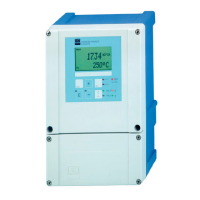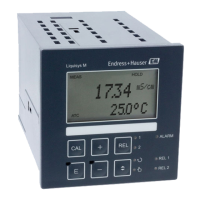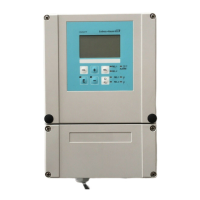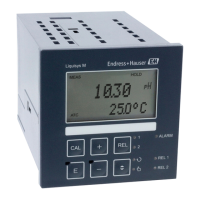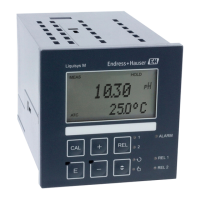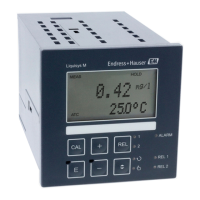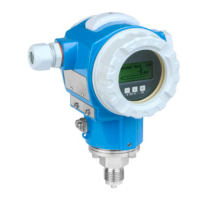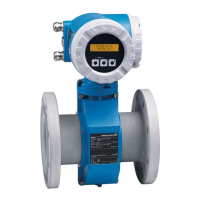Liquisys M CLM223/253 Maintenance
Endress+Hauser 91
NOTICE
Prohibited cleaning agents
Damage to the housing surface or housing seal
‣
Never use concentrated mineral acids or alkaline solutions for cleaning.
‣
Never use organic cleaners such as benzyl alcohol, methanol, methylene chloride,
xylene or concentrated glycerol cleaner.
‣
Never use high-pressure steam for cleaning purposes.
9.1.2 Cleaning the conductivity sensors
L
CAUTION
Risk of injury from cleaning agents, damage to clothing and equipment
‣
Wear protective goggles and safety gloves.
‣
Clean away splashes on clothes and other objects.
‣
Pay particular attention to the information provided in the safety data sheets for the
chemicals used.
Clean away fouling on the sensor as follows depending on the type of fouling:
• Oily and greasy films:
Clean with grease remover, e.g. alcohol, acetone, possibly hot water and dishwashing
detergent.
• Lime and metal hydroxide buildup:
Dissolve buildup with diluted hydrochloric acid (3 %) and then rinse thoroughly with
plenty of clear water.
• Sulfidic buildup (from flue gas desulfurization or sewage treatment plants):
Use a mixture of hydrochloric acid (3 %) and thiocarbamide (commercially available) and
then rinse thoroughly with plenty of clear water.
• Buildup containing proteins (e.g. food industry):
Use a mixture of hydrochloric acid (0.5 %) and pepsin (commercially available) and then
rinse thoroughly with plenty of clear water.
9.1.3 Simulation of conductive sensors for device testing
You can test the transmitter for conductive conductivity by replacing the measurement
section and temperature sensor with resistors. The accuracy of the simulation will depend
on the accuracy of the resistors.
Temperature
If a temperature offset is not set at the transmitter, the temperature values of the
following table apply:
Pt 100 equivalent resistors
Temperature Resistance value
-20 °C (-4 °F) 92.13 Ω
-10 °C (14 °F) 96.07 Ω
0 °C (32 °F) 100.00 Ω
10 °C (50 °F) 103.90 Ω
20 °C (68 °F) 107.79 Ω
25 °C (77 °F) 109.73 Ω
50 °C (122 °F) 119.40 Ω
80 °C (176 °F) 130.89 Ω
100 °C (212 °F) 138.50 Ω
200 °C (392 °F) 175.84 Ω

